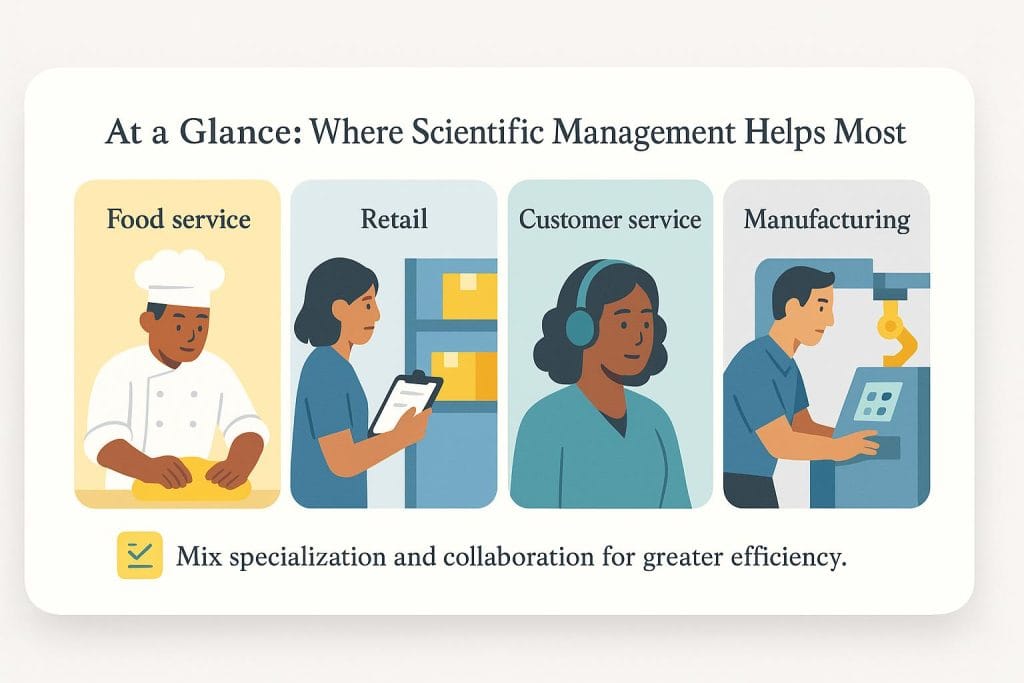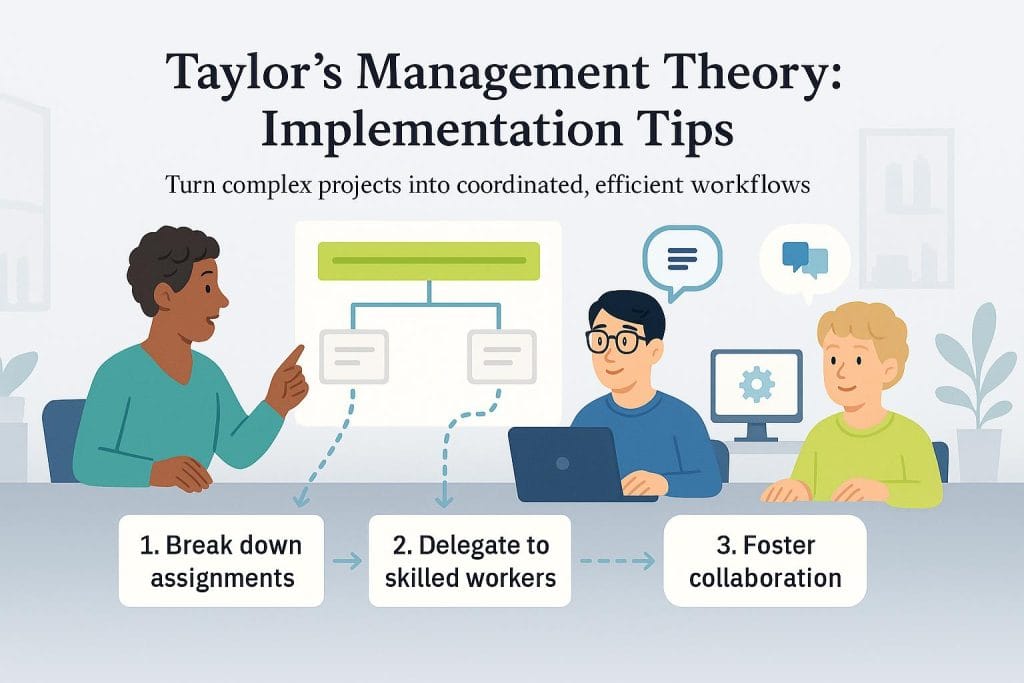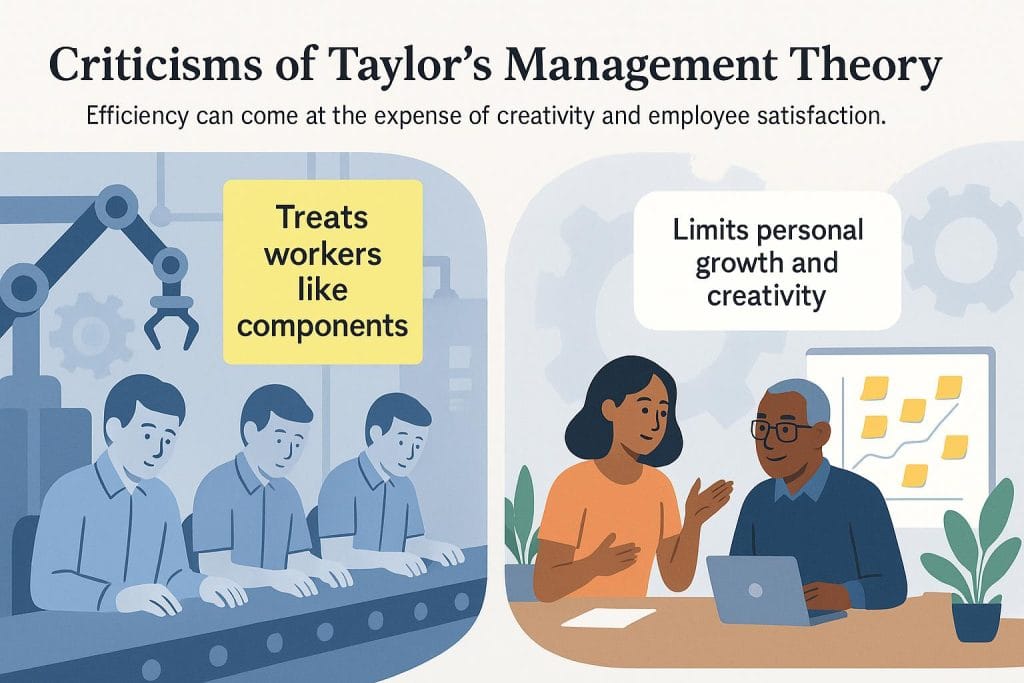Business.com aims to help business owners make informed decisions to support and grow their companies. We research and recommend products and services suitable for various business types, investing thousands of hours each year in this process.
As a business, we need to generate revenue to sustain our content. We have financial relationships with some companies we cover, earning commissions when readers purchase from our partners or share information about their needs. These relationships do not dictate our advice and recommendations. Our editorial team independently evaluates and recommends products and services based on their research and expertise. Learn more about our process and partners here.
Frederick W. Taylor & the Principles of Scientific Management
Taylor’s management theory focuses on simplifying jobs to increase efficiency, collaboration and progress toward company goals.

Table of Contents
Frederick W. Taylor – widely regarded as the founder of scientific management – revolutionized how businesses operate by introducing time-motion studies, standardized processes and incentive-based labor systems. His principles of scientific management continue to influence modern workplace efficiency.
Learn more about Frederick Taylor.
Who was Frederick W. Taylor?
Frederick Taylor was an American mechanical engineer in the late 1890s and early 1900s who prioritized the improvement of industrial efficiency. His management theory, published in the 1911 book The Principles of Scientific Management, focused on simplifying jobs to increase efficiency. Frederick Taylor is considered one of America’s first management consultants.
Timeline of Taylor’s career and impact:
- Late 1890s-early 1900s: Taylor worked as a mechanical engineer, developing his efficiency theories.
- 1911: He published The Principles of Scientific Management, establishing scientific management theory.
- Legacy: His ideas served as a foundation for Henry Ford’s manufacturing assembly line and continue to influence modern management practices.
What is scientific management?
Scientific management, also known as Taylorism, is a management theory that emphasizes the systematic analysis of work processes to maximize efficiency and productivity. According to Taylor, employers should reward workers for increased productivity rather than scold them for every minor mistake.
“The principal object of management should be to secure the maximum prosperity for the employer, coupled with the maximum prosperity for each employee,” Taylor wrote. “The words ‘maximum prosperity’ are used, in their broad sense, to mean not only large dividends for the company or owner, but the development of every branch of the business to its highest state of excellence, so that the prosperity may be permanent.”

Frederick Taylor’s scientific management theory
Taylor’s scientific management theory, also known as classical management theory, emphasizes efficiency. However, according to Taylor, employers should reward workers for increased productivity rather than scold them for every minor mistake.
Taylor’s theory had clear objectives:
- Science, not rule of thumb
- Harmony, not discord
- Cooperation, not individualism
- Maximum output, in place of restricted output
- Development of each person to their greatest efficiency and prosperity
Principles of scientific management according to Taylor
Taylor’s theory focuses on four principles. He saw these as key to increasing company efficiency and achieving “maximum prosperity” for both the business and its employees:
- Scientific task allocation: Each element of work can (and should) have a science to it.
- Selection and training: Employers should select, train and develop employees using a scientific approach.
- Collaboration: Employees and employers must collaborate.
- Division of work: Employers should divide work and responsibilities among employees.
As seen in the third principle, Taylor believed in the importance of team collaboration. Trust should be given to employees to carry out duties to the best of their abilities; the responsibility of training and optimizing processes goes to managers.
This video breaks down Frederick Taylor’s research and how it changed workplace management.
Time-motion studies and process standardization
“One of the most well-known aspects of scientific management is the practice of ‘time and motion studies,’ which incorporates the painstaking analysis of every action and movement involved in executing a job, in the interest of finding opportunities for efficiency,” Matt Paese, executive consultant at Development Dimensions International (DDI), told us. “These studies often had a positive impact on physically oriented jobs, but became less useful for more complex roles that required more judgment and decision making.”
Process standardization under Taylor’s theory involves breaking down assignments into subtasks. Managers who embrace Taylor’s theory should break down large tasks into several smaller ones rather than assign an entire project to one individual. These subtasks are meant to make the process more organized and efficient; they’ll have multiple employees working on one assignment and each individual taking care of their own piece.
Real-world applications include:
- Lean manufacturing processes
- Production line setup and optimization
- Assembly line operations (as pioneered by Henry Ford)
How Taylor’s theory applies to SMBs
While Taylor’s scientific management theory won’t work for every business or industry, it does provide advantages for certain organizations. Remember, an all-encompassing method may not work in today’s business world. This is especially true for companies where employees and managers value flexibility, room for growth and the ability to change disciplines.

These industries are well-suited to Taylor’s theory:
- Food service: The food service industry may lend itself to the assembly-line criticism, but that system is actually beneficial for this industry. Employees with specialized skill sets — like making dough, wrapping egg rolls or decorating cakes — can excel while contributing to the business in a single vertical.
- Retail: Like food service, the retail industry often relies on specialized employees to track inventory, stock shelves, interact with customers and create visual displays.
- Customer service: According to Taylor’s hierarchy, call and live chat centers typically operate with senior management overseeing many employees. Management remains responsible for analyzing numbers and identifying opportunities to improve productivity and efficiency.
- Manufacturing: Taylor’s ideas served as a foundation for Henry Ford’s manufacturing assembly line — perhaps the best example of using specialized skills in a repetitive method and monitoring the results. Manufacturing organizations that employ technicians to operate a single machine can focus on training, development and continuous efficiency improvement.
Combine Taylor’s principles of harmonious collaboration and role specialization with existing approaches that prioritize workplace satisfaction and engagement. The result is business owners being able to use Taylor’s management style to ensure their firms are operating efficiently.
“Make use of these approaches when physical productivity and efficiency are the focus,” said Paese.
Check out The Principles of Scientific Management and more books written by Frederick Taylor.
Tips for implementing Taylor’s management theory
Want to succeed with Taylor’s management theory where other companies have faltered? Then we recommend carefully implementing his scientific principles into your business’s workflow and adjusting your practices as needed. Here are some tips for successful implementation.

Break down assignments into subtasks
Assignments can be broken down into several levels. Managers can divide a months-long project into natural phases, with designated project managers who then assign subtasks to employees on their teams with specialized roles. Those employees may choose to manage their own subtasks by creating corresponding daily action items that move toward project completion or achieve an overall goal.
These assignments rely on another critical part of Taylor’s theory: collaboration. When you facilitate open communication among managers, project managers and employees, it keeps all parties involved in project updates and ensures questions are answered. [See the most effective apps for internal communication to help your company succeed in this area.]
Delegate responsibilities to skilled workers
According to Taylor’s theory, executives should measure the most efficient way to complete a given task. Then, they’ll delegate the subtasks only to employees with the proper skills and abilities to complete those tasks. Management should train those workers in whatever method was identified to complete the assignment most efficiently.
In many businesses, workers’ roles tend to be specific and fixed; their tasks are basic and repetitive. As a result, employees may feel insignificant if they complete the same chore for hours on end. In Taylor’s view, each worker plays a crucial role in a company’s success, and setting expectations can transform employees’ attitudes. When leaders delegate tasks to employees, each staffer should understand how vital they are to the success of the project. They should also realize why their skills were chosen over those of their peers.
Invest in employee training and development
When managers delegate tasks to someone who needs additional training, transparent, two-way communication is necessary to achieve the desired results. Rather than hiding gaps in knowledge or choosing to do sloppy work, employees are responsible for asking questions to ensure they fully understand their assignments.
Conversely, the manager remains responsible for providing training and troubleshooting. Also, they’re on the hook for building a positive relationship with employees that welcomes questions and feedback.
Monitor performance
There is no point in administering new processes if you’re not going to evaluate how successfully they work. It is equally vital to measure employee performance. To achieve Taylor’s goal of maximum prosperity, you need to determine what is and isn’t increasing efficiency for your business and your workforce.
Supervisors must ensure that each worker on their team is doing their job efficiently. If a more productive practice is discovered, workers should be retrained to implement it in their work.

For example, the COVID-19 pandemic pushed many businesses to reexamine procedures, especially regarding in-office attendance. The “We’ve always done it this way” reasoning lost its ground when global shutdowns occurred and decision-makers realized many types of employees could complete their work — often with better efficiency — at home. After shutdowns ended, businesses evaluated how their operations had changed. Then, based on what they saw, they prioritized work-from-home productivity and increased employee satisfaction over inefficient in-person procedures.
Allocate work between managers and employees
Taylor believed in a hierarchy of three levels, with the most powerful workers on top. According to his model, each level has precise responsibilities and specific instructions. Both managers and employees respect and adhere to those above them and do only what is assigned to them.
Divisions of labor won’t always appear equal. But, leaders should strive to allocate tasks to specialized roles and clearly state expectations — and the value of the employee’s work toward the company’s overall goals. This practice will ensure collaboration and optimal performance.
Taylor vs. other management theorists
Taylor’s management theory is only one of many popular management theories that could suit your needs. Here are alternative theories that might align more closely with your business approach and company’s goals and how they compare to Taylor’s scientific management approach.
Mayo vs. Taylor: Human relations versus scientific management
Elton Mayo’s human relations management theory is based on the Hawthorne experiments. While Taylor emphasized monetary incentives and physical working conditions as primary motivators, Mayo introduced the idea that employee productivity is driven by relational and social factors rather than monetary incentives or physical working conditions.
Taylor believed workers were inherently lazy and needed constant supervision, treating them as “parts of a machine”. In contrast, Mayo found that elements like attention, camaraderie and communication significantly influence motivation and workplace satisfaction. That lays the foundation for the human relations movement in management.
His theory emphasizes the importance of group norms and cohesion in team success. Mayo advocated for participative management where employees are involved in decision-making, directly opposing Taylor’s top-down, authoritative approach. Prioritize open communication, foster teamwork and address employees’ emotional and social needs. That way, Mayo’s approach can help businesses create healthier work environments, improve employee retention and enhance overall productivity.
>> Learn More: The Management Theory of Elton Mayo
Weber vs. Taylor: Bureaucratic structure versus scientific efficiency
German sociologist Max Weber believed bureaucracy was the most efficient business structure. While Taylor focused on optimizing individual tasks and worker efficiency through scientific methods, Weber’s management theory, also known as the bureaucratic theory, advocates for transparent power distribution enforced by strict rules. Both theorists emphasized efficiency, but Taylor concentrated on the production level while Weber focused on organizational structure and hierarchy. He believed such a system was necessary for large corporations to maximize their productivity and achieve results.
Bureaucracy today is often associated with frustrating, tedious processes and endless red tape. But, the ideal bureaucracy Weber envisioned emphasizes equality, transparency with open lines of communication and a simple rationale for the division of tasks. Much like “the American dream,” Weber’s management theory advocates for employee advancement through merit rather than connection or privilege.
>> Learn more: The Management Theory of Max Weber
Fayol vs. Taylor: Administrative management versus scientific management
Henri Fayol, known as the “father of modern management,” developed a theory that contrasts significantly with Taylor’s scientific management approach. While Taylor focused on the production level and optimizing individual worker efficiency through scientific methods, Fayol emphasized top-level management and overall organizational administration.
Fayol’s administrative management theory introduced 14 principles focusing on management functions like planning, organizing, commanding, coordinating and controlling. In contrast, Taylor developed four principles specifically aimed at increasing worker productivity through time and motion studies. Where Taylor treated workers as individuals whose performance needed optimization, Fayol viewed workers as part of a coordinated organizational system.
Fayol’s approach was based on personal experience and emphasized human factors like teamwork, equity and stability. Taylor’s scientific approach relied on observation and experimentation, placing less importance on human elements and more on standardization and economic incentives. Fayol’s principles have universal applicability across all management levels, while Taylor’s techniques are primarily focused on production-level operations.
>> Learn more: The Management Theory of Henri Fayol
Modern interpretations and critiques of scientific management

Taylor’s pro-employee approach to efficiency was ahead of its time. His general principles have gained traction in today’s business climate, in which workers have shunned toxic work environments and prioritized work-life balance.
While Taylor’s theory makes for more efficient workers, it does have some flaws. For example, many of the subtasks Taylor favored may be considered menial by some employees; they could cause workers to feel like they’re part of an assembly line instead of creative contributors. Some critics have argued that Taylor’s writings are robotic and impersonal. Others have noted his framework’s lack of growth potential for individuals with advanced skills.
“Treating workers like machine components breeds resentment and crushes creativity, which directly contradicts today’s companies’ innovation needs,” said Kevin Shahnazari, founder and CEO of FinlyWealth. “Rigid time-motion studies and standardized workflows often create an oppressive environment where employees feel micromanaged and devalued.”
Whenever his theory broke down in practice, Taylor would attribute the error to improper application. Such a designation could include a manager’s unwillingness to depart from inefficient traditional procedures and/or their expectations that employees complete more work for the same pay. However, when Taylor’s practices are executed properly, improved productivity is still a valuable result. Depending on your industry, his theory could be a great addition to your business.
FAQs: Frederick Taylor and scientific management principles
Source interviews were conducted for a previous version of this article. Sammi Caramela contributed to this article.













